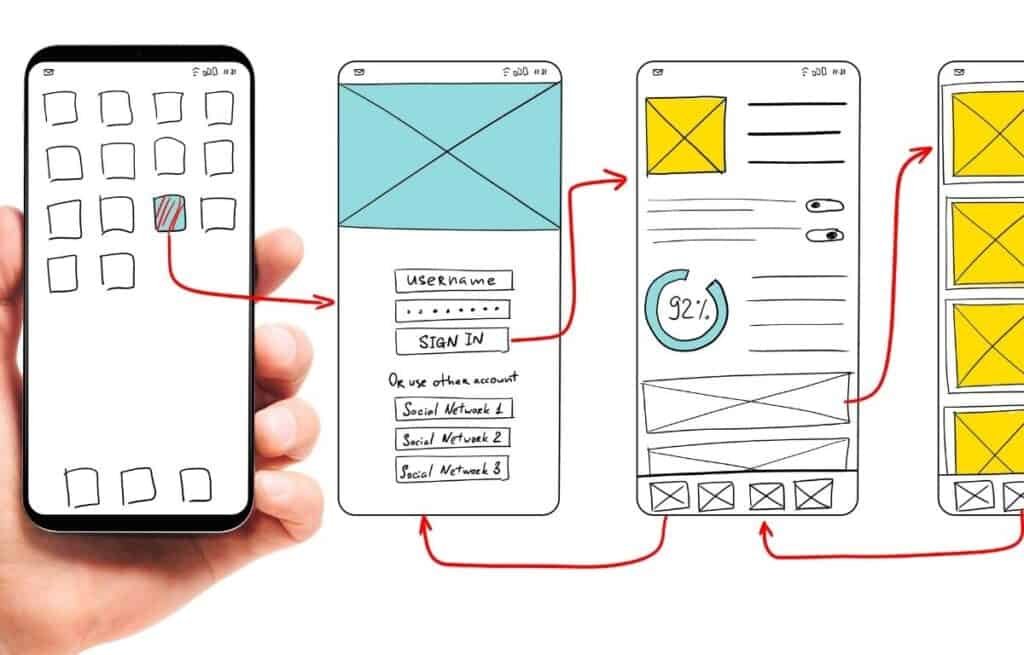एक सफल मोबाइल ऐप बनाने के लिए 9 कदम
Eager to create your own mobile app but feeling stuck? Well, this is the guide you need to get started.
There’s no doubt that mobile apps are becoming more and more popular every day. In fact, it’s estimated that there are around 6.6 billion smartphone users in the world today, according to Statista.
This means that with a proper app development strategy, you can create an app for mobile phones that a significant number of people will want to use. If you’re thinking of creating a successful mobile app for your startup or existing business, then you need to make sure you follow these steps.
1. Come up with your app idea

The first thing you need is an idea of the app you’re going to create. This should be something that solves a problem or makes someone’s life easier in some way.
While you’re free to come up with an app no one has ever seen, you don’t have to invent or even reinvent anything. You can get ideas from what’s already working for other mobile app developers.
In fact, there are many successful apps that simply modeled others. You just improve an existing app by adding elements it doesn’t have.
It helps to have some uniqueness in your app to stand out among the rest. You also need to provide more value so that your app can attract more users.
2. Validate your app idea
Once you have your app idea, the next step is to validate it. You shouldn’t start designing or coding your app before knowing whether it will perform well. It would be best to Research whether there is a market for your app idea.
There are a few ways to validate your app idea:
- Look at whether there are any existing apps that do something similar. Check the number of downloads, ratings, and reviews on Google Play, App Store, or any other app distribution platform. What can you do to make your app better?
- Talk to people who might be potential users of your app and get their feedback. Go to social media networks and forums and ask questions. Create polls and surveys online that people can take and give you their opinion.
- Create sample landing pages about your app and demo versions to see what users think. If a significant portion of them are looking up to it and the reviews are mostly positive, you’re good to go.
3. Decide on your mobile app’s features
The next step is to decide on your app’s features. You need to make a list of all the features you want your app to have and what each one will do for users.
You also need to prioritize these features by importance. This way, if you’re short on time or budget, you can still release a न्यूनतम व्यवहार्य उत्पाद (MVP) that has the most important features.
Some of the questions you need to ask yourself when deciding on your app’s features are:
- What are your core value propositions?
- What does your app do better than any other existing app?
- Who is your target audience?
- What do they want from an app like yours?
- What platform will you build your app for and what features does that platform support?
- What resources do you have available for development? This includes time, money, and expertise.
Also, keep in mind that there are several basic features your app may need depending on your niche. These features include chat support, a search option, and push notifications.
4. Design the app

When you’ve validated your app idea, it’s time to start thinking about the design. The design of your app is important because it needs to be user-friendly. Users shouldn’t have a hard time navigating your app.
You need to consider the following things when designing your app:
Layout: How will you arrange the different screens of your app? Will it be easy for users to navigate?
Visuals: What colors and images will you use in your app? Do they match your brand identity?
Fonts: Which fonts will you use in your app? Do they make the text easy to read?
Calls to action: What do you want users to do when they use your app? Do you want them to subscribe, make a purchase, or do anything else? Make sure your call to action is clear and visible.
Designing a great app isn’t easy, but it’s worth taking the time to get it right. A poorly designed app will be hard to use and will likely turn users away.
5. Develop your app
After you’ve designed your app, it’s time to start developing it. This is where the actual coding takes place.
You can either develop your app yourself or hire a development team to do it for you. If you’re going to develop the app yourself, then you need to be proficient in the programming language you’re going to use. Also, there are lots of no-code app builders that make it easy to develop mobile apps.
If you’re going to hire a development team, then you need to make sure they have experience in developing mobile apps. Ask them for examples of apps they’ve developed and get feedback from their previous clients.
You also need to decide which platform you’re going to develop your app for. There are many different platforms available for developing mobile apps, such as iOS, Android, and Windows phones. Each platform has its own strengths and weaknesses, so you need to choose the one that’s right for your app depending on factors like your budget.
6. Test your mobile app
As soon as your app is developed, it’s time to test it. Testing is important because it allows you to find and fix any bugs in your app before you launch it.
Numerous ways to test your new mobile app exist, including beta testing, usability testing, and unit testing. Beta testing involves giving your app to a group of users and getting their feedback. Usability testing is about testing how easy it is to use your app. Unit testing involves testing the different units of code in your app to make sure they’re working correctly.
You can either test your app yourself or hire a team of testers to do it for you. If you’re going to test your app yourself, then you need to be familiar with the different testing methods. If you’re going to hire a team of testers, then you need to make sure they have experience in testing mobile apps.
7. Create a marketing plan

After you’ve developed and tested your app, it’s time to determine how to market it. You need to create a marketing plan that will help you promote your app and get users to download it.
There are many different ways to market your mobile app, such as paid advertising, social media marketing, and email marketing. You need to choose the right marketing channels for your app depending on your budget and the goals you want to achieve.
You also need to create a landing page for your app. A landing page is a website where users can learn more about your app and download it. Your landing page should be well-designed and informative. It should also have a strong call to action that encourages users to download your app.
8. Launch your app
Now that you’ve tested your mobile app and made sure it’s free of bugs, it’s time to launch it. Launching your app is an important step because it allows users to finally start using your app.
Before you launch your app, you need to do some preparation. This includes things like writing a press release. You also need to create an App Store listing and choose a price for your app.
When you’re ready, you can launch your app on the App Store or Google Play. Make sure you promote your app and get it in front of as many people as possible.
And now you’ve launched your new mobile app! Congratulations to you!
9. Maintain your app
After you’ve launched your mobile app, you need to start thinking about maintenance. This includes things like updating your app regularly and providing customer support.
You need to listen to the concerns of the first app users you get. Monitor your online reviews and reply accordingly. If you fix the troubles people are facing, they can update their reviews to add more positivity and make others want to try the app too.
When you have a good number of users on your mobile app, you also need to think about how you’re going to monetize it. There are many different ways to monetize mobile apps, such as paid subscriptions, in-app purchases, and advertising. You need to choose the right monetization model for your app depending on your business goals.
Conclusion: What to do next
As you can see, creating a successful mobile app is a lot of work, but it’s definitely possible. You need a good app idea as well as a proper strategy to develop, launch, and market it.
Just follow these steps and you’ll be on your way to developing a successful app in no time. Good luck with your mobile app creation!







